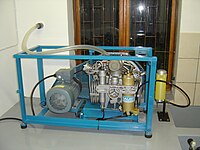
Photo from wikipedia
A non-isothermal moving-boundary model for food dehydration, accounting for shrinkage and thermal effects, is proposed and applied to the analysis of intermittent dehydration in which air temperature, relative humidity, and… Click to show full abstract
A non-isothermal moving-boundary model for food dehydration, accounting for shrinkage and thermal effects, is proposed and applied to the analysis of intermittent dehydration in which air temperature, relative humidity, and velocity vary cyclically in time. The convection-diffusion heat transport equation, accounting for heat transfer, water evaporation, and shrinkage at the sample surface, is coupled to the convection-diffusion water transport equation. Volume shrinkage is not superimposed but predicted by the model through the introduction of a point-wise shrinkage velocity. Experimental dehydration curves, in continuous and intermittent conditions, are accurately predicted by the model with an effective water diffusivity Deff(T) that depends exclusively on the local temperature. The non-isothermal model is successfully applied to the large set of experimental data of continuous and intermittent drying of Rocha pears.
Journal Title: Foods
Year Published: 2020
Link to full text (if available)
Share on Social Media: Sign Up to like & get
recommendations!